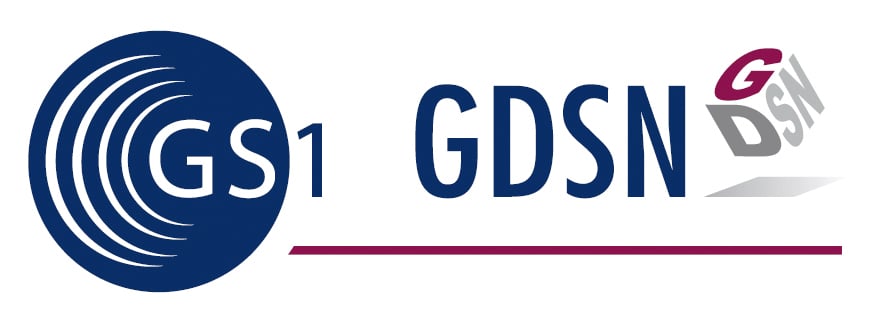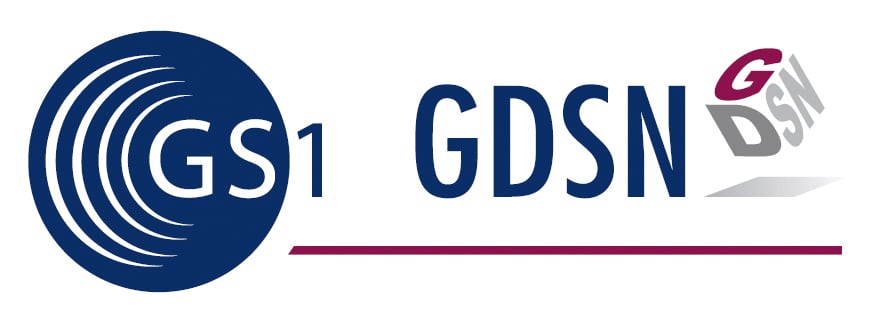
We feel your pain: communication across the e-commerce supply chain kind of sucks. But we also bring good news! There are standards like GS1 that are waiting to rescue you - if only you can understand what they do.
GS1, simply put, works to eliminate this problem by providing standards that make communication up and down the e-commerce supply chain less frightful.
In this post we’ll introduce you to GS1 and walk you through two of their biggest initiatives: GPC and GDSN. (Hopefully you won't burn out on 3-4 letter acronyms along the way!)
Why is this introduction important? Because through these initiatives, GS1 is pioneering the future of your business, and we thought it was only fair to let you in on how.
GS1 AND LIFE AS YOU KNOW IT
Take a step back and think about all the factors that shape the way your company composes information about your products. You likely tailor your product data to your target customers, what your e-commerce platform and design allow for, what your back-end ERP and PIM systems require, etc.
Under these circumstances, it’s quite easy to see how companies develop their own unique “languages” for talking about their products to make moving data between these systems easier. And, in a similar vein, it’s also easy to extrapolate how difficult and costly it can become for companies to interpret other product data “languages” apart from their own.
Imagine, for example, if every single company invented their own barcode system. Among the many business processes this would complicate is shipping: one company scans a product on the way out and the receiving company has to replace the barcode with their own barcode on the way in. Frustrating, inefficient and completely unnecessary!
That’s where GS1 comes in. This is an admittedly horrible analogy, but it aims to be the Esperanto of product data.
GS1 is an international organization aimed at creating a “global language of business.” It offers various solutions – like product barcodes – that make it easier and cheaper for companies to quickly identify and keep track of products that are catalogued in different data “languages” today.
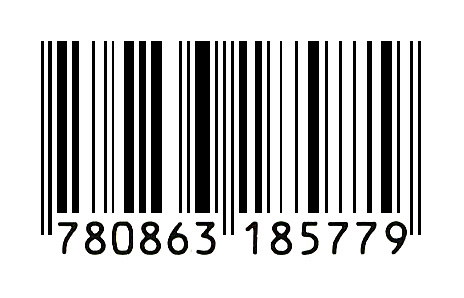
The barcode - GS1's most iconic standard.
In addition to the barcode, the GPC (Global Product Classification) system and GDSN (Global Data Synchronisation Network) are two initiatives working hand-in-hand to usher more structured communication into the marketplace, and are important indicators for where e-commerce is headed.
GPC: ATTEMPTING COMMON LANGUAGE OF E-COMMERCE
Think about how difficult it can be when you go to a new store looking for a basic item, like hand soap. You usually buy hand soap at your local drugstore, where the body washes and shower gels all segue nicely into hand soaps in the personal care section of the store.
But at this new store, the hand soap is nowhere to be found next to personal care. You talk to a clerk. Duh, she says, hand soap is always in the kitchen aisle next to the multipurpose cleaners.
Much in the same way that products are physically categorized on shelves, different companies have different schema for internally categorizing and organizing their products. This calls for an expensive and unnecessary headache every time products move from one company to another, and have to be merged into another catalog’s classification for organizing products.
GS1’s GPC system provides a standard for this classification. The system has broken down much of the retail landscape into standard industry segments, which are then broken down further into families and classes of products.
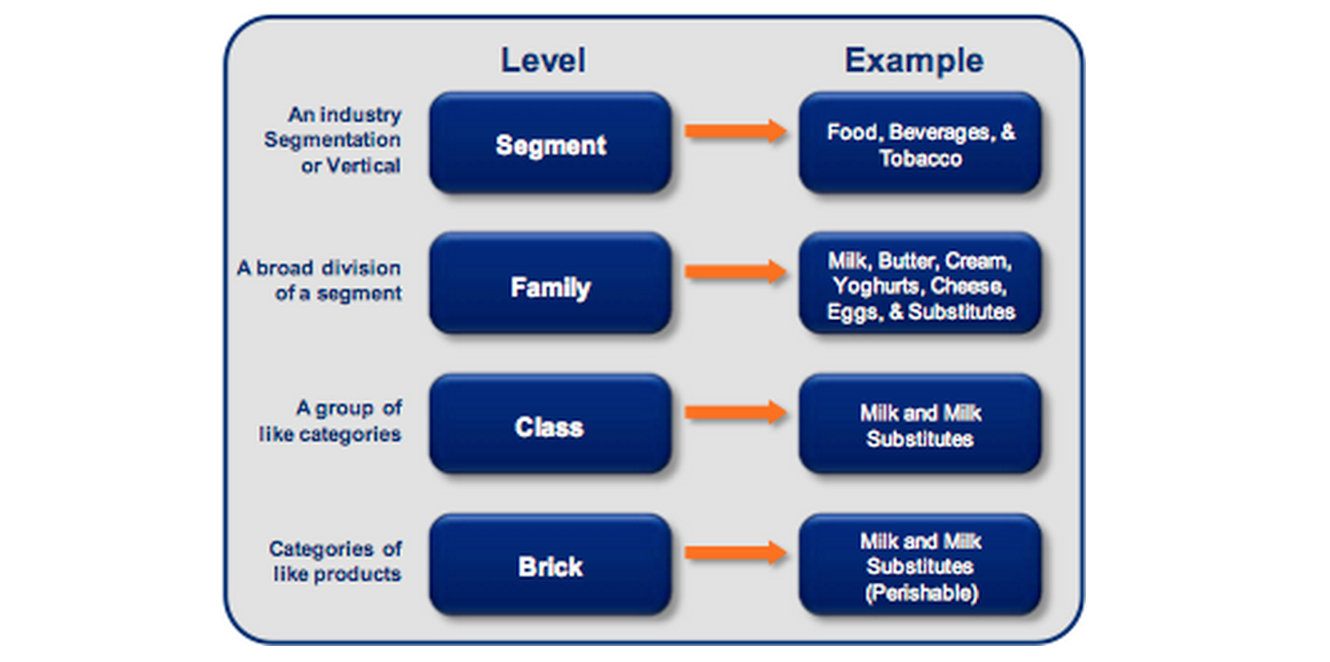
This example from the GS1 website explains how GPC works for food products.
The heart of GPC, however, is the “brick.” GS1 defines “bricks” as “categories of like products,” and each “brick” contains standard attributes that must be defined by each company for each product.
For example, Brick 10001071 is the “Athletic Footwear – Specialist” brick in the GPC footwear class. All products that fall into this brick will be categorized by this brick number.
Furthermore, they will be classified by six brick attributes: Fastening Type, Footwear Consumer Lifestage, Target Gender, Type of Athletic Footwear, Type of Specialist Activity, and Upper Material Type. For each attribute, manufacturers have to chose one of the preset choices that best represents their product.
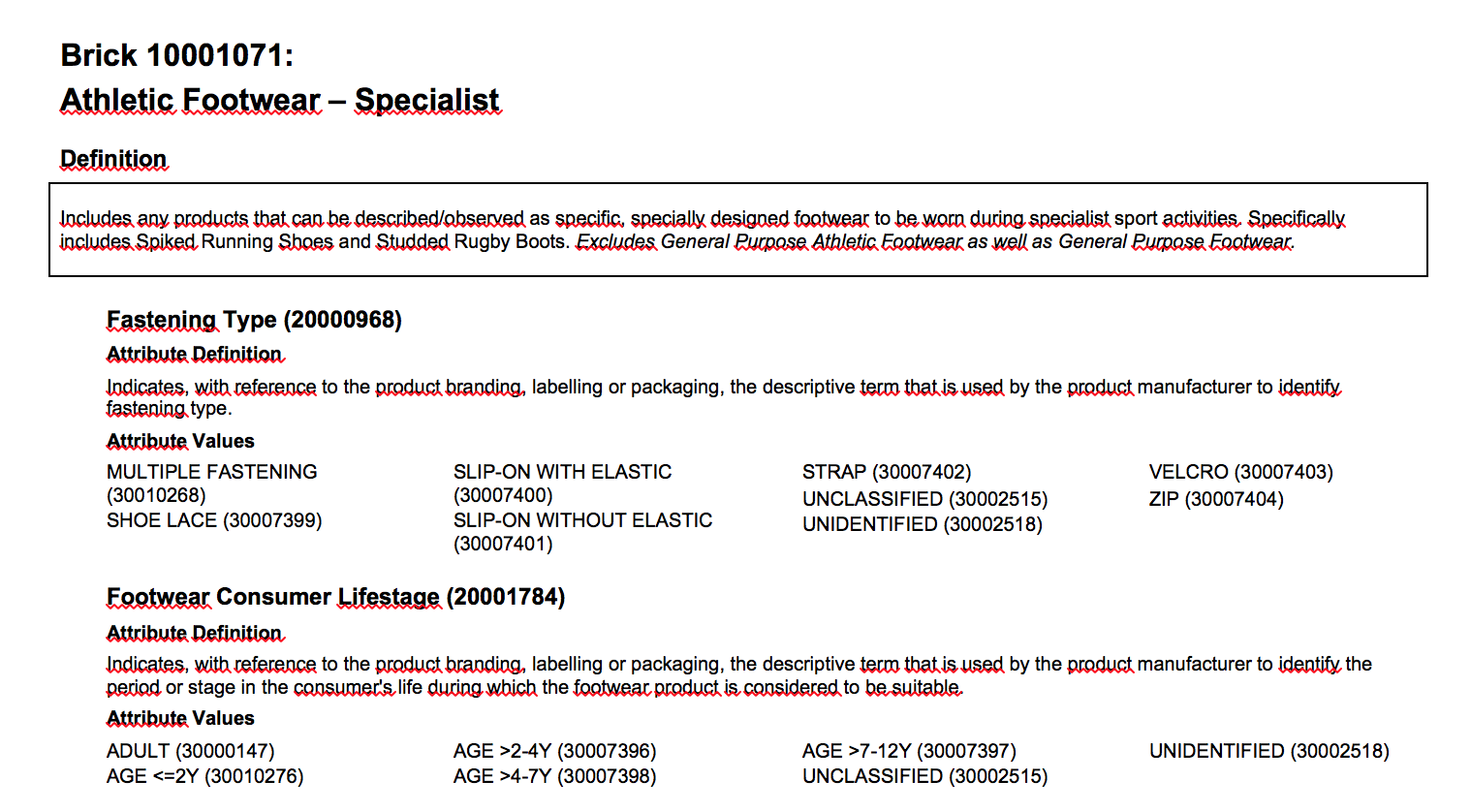 "
"A snapshot of the GS1 info sheet for footwear.
By creating a standardized format for classifying products, GPC allows companies to more easily move products between catalogs. (Just think about a brand that can now easily share a product - and that product's pre-populated category information - with its retail partners.) It ensures that a product will be located on the same virtual shelf no matter where a person is looking for it. This saves a tremendous amount of time, money, and headache as companies grow their product assortment from numerous suppliers.
GPC: Universal Solution?
That all said: while GPC is a big step in the right direction – and one that will definitely make exchanging content easier - it’s definitely not a complete solution to the problem.
For one thing, any universal product category structure will almost always need to be mapped to e-commerce specific category structures for individual companies. For example, let’s say you’re ionlysellsoap.com; you don’t need a soap category. Instead you need a “moisturizing soap” vs. “antibacterial” soap, which may not be categories in GPC.
Also you don’t want to just slap on the standard features that come with a GPC-compliant product feed, as you’ll want to tailor them to your audience. Moreover, especially with technical products, specs and features change too rapidly for effective standardization.
GDSN AND A LIVING, EVOLVING PRODUCT CATALOG
While GPC is great for introducing products to new catalogs the first time, what happens when information changes? As a manufacturer, how do you communicate to your distributors that you’ve switched out an ingredient in one of your fragrances, or miscalculated the weight of your most popular shoe? As a distributor, how do you make sure that you’re communicating the most accurate information about your products to your customers?
GDSN (the Global Data Synchronization Network), as the name suggests, synchronizes product data across its network. So if any product data in the network changes, that change is instantly communicated to all companies in the network who distribute that product.
How does this work?
To begin, Manufacturer A loads its product data into a GDSN-certified data pool – or standardized electronic product catalog typically hosted by a third party - that is monitored by the GS1 Global Registry. (GS1 refers to this body as its “information directory.”)
When Distributor B wants data about Manufacturer A’s products, it sends a request through its own data pool for that information. The request goes to the GS1 Global Registry for approval, who then sends the request to Manufacturer A’s data pool. The data pool pulls the requested information, sends it back to Distributor B’s data pool, and Distributor B now has access to the information.
Though these data pools may seem like unnecessary middlemen in the product data exchange (wouldn’t it be easier if Manufacturer A and Distributor B just talked to each other?), remember that these pools standardize your product data in a common language, so it turns out not to matter. Much in the same way that your request to see this blog post goes through dozens of middlemen servers and networks, so does the GDSN requests to update product data.
Also, remember GPC? That’s the very language they use.
So not only are you spared the task of contacting each of your downstream channels about the change in product data, you also don’t have to customize that message to the “language” each of these channels speaks in. GDSN does all that work for you.
GDSN: Right for Me?
GDSN is used by many organizations – especially large ones – for communication product specs and logistics information. However, integrating with a GDSN data pool is a technical process (XML, anyone?) that is hard to make work without dedicated IT resources, so small-mid-sized manufactuers do not participate as much in the network. (Shameless plug: that’s where a tool like Salsify can help!).
Furthermore, GDSN does not contain every last bit of product detail you want on your product detail page. It doesn’t have 3-5 benefits for your audience, or a description that’s short enough for a tweet, or a retina-friendly image, etc. So while you can get a lot of product specs via GDSN it leaves gaps that marketers and merchandisers must fill in using other means.
CONCLUSION
As e-commerce becomes increasingly concerned with providing customers the most complete, up-to-date information about products as possible, the standardization in communication spearheaded by GS1 will become ever more prevalent. Even if you decide that subscribing to GPC and GDSN isn’t right for your company's size and objectives, understanding these trends will still give you a leg up on your competition.
Written by: Emily Saka
Recent Posts
10 Brand Examples of Click-Driving Product Images, Videos, and More To Inspire
Summit Spotlight: Salsify Leaders Share How To Advance to the Next Decade of the Digital Shelf
Omnichannel Strategy: Here Are the Top 3 Drivers of Omnichannel Profitability
Subscribe to the Below the Fold Newsletter
Standing out on the digital shelf starts with access to the latest industry content. Subscribe to Below the Fold, our monthly content newsletter, and join other commerce leaders.


